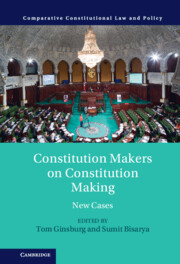Book contents
- Constitution Makers on Constitution Making
- Comparative Constitutional Law and Policy
- Constitution Makers on Constitution Making
- Copyright page
- Contents
- Contributors
- Acknowledgments
- 1 Introduction
- 2 Making and Remaking Kenya’s Constitution
- 3 Kosovo’s Independence Constitution
- 4 Decisions, Deadlocks and Deadlines in Making South Africa’s Constitution
- 5 Makers of Our Own History
- 6 Nepal’s Constitutional Development and the Challenges of Constitution Making
- 7 The Constituent Process in Ecuador
- 8 Burundi
- References
1 - Introduction
Constitution Makers on Constitution Making*
Published online by Cambridge University Press: 03 November 2022
- Constitution Makers on Constitution Making
- Comparative Constitutional Law and Policy
- Constitution Makers on Constitution Making
- Copyright page
- Contents
- Contributors
- Acknowledgments
- 1 Introduction
- 2 Making and Remaking Kenya’s Constitution
- 3 Kosovo’s Independence Constitution
- 4 Decisions, Deadlocks and Deadlines in Making South Africa’s Constitution
- 5 Makers of Our Own History
- 6 Nepal’s Constitutional Development and the Challenges of Constitution Making
- 7 The Constituent Process in Ecuador
- 8 Burundi
- References
Summary
Constitution-making has changed dramatically in recent decades. Compared with constitutional processes in earlier eras, we observe the increasing role of the international community in constitution making, often as part of a broader intervention into a conflict, and increasing penetration of international norms into national contexts. There has also been a trend toward public participation in the process of constitution-making. In addition, constitution making is now iterated over time, with multiple rounds of decision making and bargaining.This chapter draws on the framework of Jon Elster to frame the seven case studies in the volume, drawing toegether themes and trends.
- Type
- Chapter
- Information
- Constitution Makers on Constitution MakingNew Cases, pp. 1 - 36Publisher: Cambridge University PressPrint publication year: 2022

